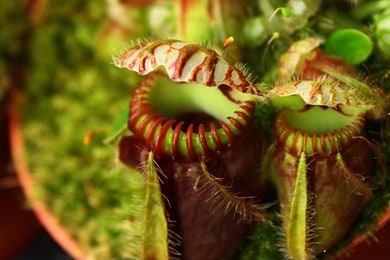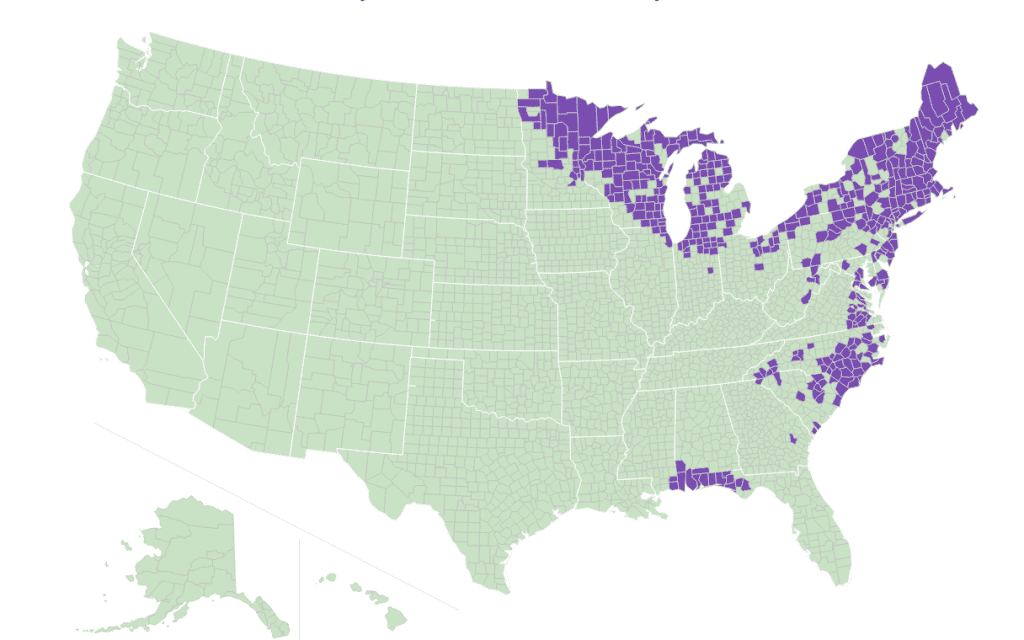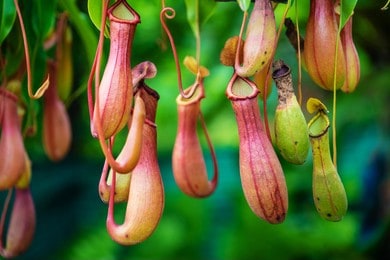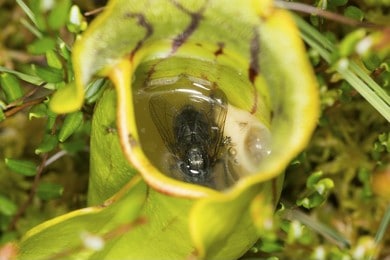The eight species of Sarracenia (Pitcher Plants) are weird and stunning looking, and they make fearsomely effective flycatchers. American pitcher plants have it all.

Most have tall, narrow pitchers which attract insects with brilliant colors and appealing smells. Visitors are deceived by transparent leaves or lured into dangerous positions by waxy surfaces while being intoxicated by poison-laced nectar. The plant’s own enzymes quickly decompose those who fall and slide down the pitcher after being caught by downward-facing hairs.
Pitcher plants thrive in sunny, open wetlands and are primarily found on the southern coastal plains of North America. Although one species extends north along the east coast into the Upper Midwest and Canada, Alabama, Georgia, and South Carolina have the most diversity. Due to the flooding of their habitats for house constructions, sarracenia populations have dramatically decreased in recent years. Some species are currently in grave danger of extinction.
The fundamentals of cultivation will be covered in this article, from water and soil to feeding and dormancy. The best place to begin is with their natural habitat in order to successfully grow these gorgeous plants and comprehend the difficulties surrounding their conservation.
Table of Contents
In which USA regions do Pitcher Plants grow?

The Species of Sarracenia
There are currently 8 accepted species of Sarracenia (taxonomic debate aside!). These include S. rubra, S. minor, S. oreophila, S. psittacina, S. leucophylla, S. alata, S. flava, and S. leucophylla. Check out the pictures below for a general overview. Each species differs significantly from one another, and some are further broken down into subspecies.
Alata, flava, leucophylla, minor, oreophila, psittacina, purpurea, and rubra are the eight species of Sarracenia, the North American pitcher plant.
Alata, flava, leucophylla, minor, oreophila, psittacina, purpurea, and rubra are listed from top to bottom, left to right.
North American pitcher plants are remarkable in that all species may be hybridised, and that these crossings result in fertile offspring. In other words, the taxonomy of Sarracenia includes a wide variety of intricate hybrids, backcrosses, and cultivars, many of which are really stunning.
Unsurprisingly, a lot of hybrids can be found in the wild naturally and used to have species designations. For instance, S. catesbaei is a cross between S. flava and S. purpurea. Another reason hybrids, along with the incredibly hardy S. purpurea, are usually suggested to novice gardeners and marketed at garden centres is the vigour that hybrids frequently display.
Sarracenia need constant, direct sunlight. Because they require direct sunshine to grow, they should only be placed on the brightest windowsills. Without it, your plants will become weak and unattractive. Your best hope is a smaller species like S. purpurea or a hybrid including it if you want to try windowsill gardening.
In general, terrariums are inappropriate. While seedlings can grow in a terrarium, it will be difficult to give the level of light that adult plants need. Also keep in mind that erect species like S. leucophylla can grow to about a metre in height!
In general, greenhouses and conservatories without heat are the best places for sarracenia to grow. They can withstand temperatures as high as 32°C (90°F) in their natural habitats on a regular basis during the summer. While some varieties can be grown outside all year round in the UK, such as in bog gardens, the taller species are often less tolerant of high winds and are therefore better suited to growing behind glass.
Division and Winter Dormancy

All pitcher plants in North America require a cold winter hibernation from November to February. You must give plants in cultivation a cold season since they frequently experience winter temperatures below freezing (zero degrees Celsius, or 32 degrees Fahrenheit).
If you keep your plants indoors throughout the growth season, you’ll need to shift them to a colder location. For instance, place them next to a window in your shed or garage. Unheated greenhouses are suitable for storing plants over the winter. The species found further north—S. purpurea, S. flava, and their hybrids—are often the hardiest in UK conditions for year-round outdoor cultivation (i.e. exposure to the elements).
Pitchers will turn brown as the days grow shorter and the temperature decreases, and your plant will begin to wither. You can safely remove any dead growth because this is typical. In the fall, some Sarracenia will also grow phyllodia, which are flat, carnivorous leaves that typically persist through the winter.
If your plants need to be repotted or even divided, the end of the winter dormancy period is a good time to do so. Adult plants can fit in a 12cm (4.5 inch) pot. A rhizome, or broad underground stem from which roots and leaves shoot, is the source of sarracenia growth. Rhizomes of large adult plants frequently have many growth points, making it possible to reproduce multiple (genetically identical) plants by snapping the rhizome and potting the pieces individually.
Soil & Water

Sarracenia needs a lot of rainwater or distilled/deionized water, just like many other carnivorous plants do. They have evolved to suck nutrients from prey because they thrive in low-nutrient, wet soil. As a result, you must stay away from tap water, bottled water, and filtered water because they will all lead to a buildup of minerals and harm your plant’s health. For identical reasons, you should stay away from fertiliser.
Avoid watering from the top while your plants are growing by standing their pots in about 2 cm (just under an inch) of water. The soil should not be kept completely wet over the winter.
Sphagnum peat moss and either perlite or lime-free horticultural sand are typically combined in a 2:1 ratio as the standard compost for Sarracenia. From specialized nurseries and on Amazon, you may get suitable peat-based Sarracenia mixes. Some producers are switching to peat-free blends because of the effects of peat extraction on the environment, including habitat damage and global warming. A 2:1:1 mixture of finely powdered bark, lime-free horticulture grit, and perlite is best
How do you encourage a pitcher plant to grow?
Make sure the pot is resting on the stones, not standing in water, and add just enough water to keep the pebbles moist. If water gets into the drainage hole, the plant will decay. Feeding – Pitcher plants don’t need a lot of extra fertiliser, but they can use a small bit of an acidic fertiliser once in a while.
How long does it take for a pitcher plant to grow pitchers?
It takes time for pitcher plants to mature and produce pitchers. It may take between five and ten years for them to mature and grow pitchers
Should I cut the dead pitchers off my pitcher plant?
Trim off pitchers and leaves as they naturally wither to maintain the plant’s health. To promote the growth of side shoots, prune back the green vine stems.
Can I feed my pitcher plant dead bugs?
To avoid overwhelming the carnivorous plant, use little bugs that are roughly one-third the size of the traps. These plants can be fed with live or dead insects.
